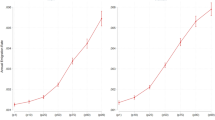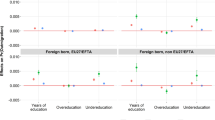Abstract
During the last decade Brazil has seen an astonishing reversal in the original north-east-to-south-east direction of migration. Within a framework of human capital and self-selection theory we try to identify the individual characteristics and motivations linked to the migration pattern. The overall results of this procedure suggest that there is a key difference between NE \({\Rightarrow }\) SE movers and SE \({\Rightarrow }\) NE movers. (1) SE \({\Rightarrow }\) NE movers were adverse self-selected in terms of observable education characteristics. (2) No self-selection could be observed among migrants in the NE \({\Rightarrow }\) SE direction. In general the North-East seems less attractive to highly skilled people. (3) Labor market segmentation with respect to sector occupation is likely. (4) There are clear differences in income determinants between movers and non movers. The majority of migrants except for migrants with higher education cannot expect to realize a return to education comparable to the average in the region of departure or destination. However, in the context of the Borjas selection model the returns to education analysis would predict a different pattern of migrant selectivity than the one observed in Brazil. Apart from soft characteristics connected to the regions we believe, that the large share of the non formal labor market is likely to indicate a surplus labor leading to a migration pattern different than expected from selection theory.
Similar content being viewed by others
References
Azzoni CR (2001) Economic growth and regional income inequality in Brazil. Ann Reg Sci 35(1): 133–152
Azzoni CR, Servo LM (2002) Education, cost of living and regional wage inequity in Brazil. Papers Reg Sci 81(2): 157–175
Borjas GJ (1987) Self-selection and the earnings of immigrants. Am Econ Rev 77(4): 531–553
Borjas GJ, Bronars SG, Trejo SJ (1992) Self-selection and internal migration in the United States. J Urban Econ 32(2): 159–185
Chiquiar D, Hanson GH (2005) International migration, self-selection, and the distribution of wages: evidence from Mexico and the United States. J Polit Econ 113(2): 239–281
Chiswick B (1999) Are immigrants favorably self-selected?. Am Econ Rev 89(2): 181–185
Dahl GB (2002) Mobility and the return to education: testing a Roy model with multiple markets. Econometrica 70(6): 2367–2420
Fiess NM, Verner D (2003) Migration and Human Capital in Brazil during the 1990s, The World Bank, Policy Research Working Paper Series, 3093
Golgher AB, Rosa CH, Araújo AFdJ (2005) The Determinants of Migration in Brazil, Discussion Paper 286
Graham DH (1970) Divergent and convergent regional economic growth and internal migration in Brazil, 1940–1960. Econ Dev Cult Change 18(3): 362–382
Heckman JJ (1979) Sample selection bias as a specification error. Econometrica 47(1): 153–161
Hunt J (2004) Are migrants more skilled than non-migrants? Repeat, return, and same employer migrants. Can J Econ 37(4): 830–849
IBGE (2004) Pesquisa Nacional por Amostra de Domicilios, IBGE 2004
Jong GFD (2000) expectations, gender, and norms in migration decision-making. Popul Stud 54(3): 307–319
Laurini M, Andrade E, Pereira PL (2005) Income convergence clubs for Brazilian municipalities: a non-parametric analysis. Appl Econ 37(18): 2099–2118
Lin G (1997) Elderly migration: household versus individual approaches. Papers Reg Sci 76(3): 285–300
Pinto da Cunha JM (2002) The use of PNAD in migratory analysis: possibilities. lacks and methodological challenges. IPEA working paper no. 875, April 2002
Roy AD (1951) Some thoughts on the distribution of earnings. Oxford Econ Papers 3: 135–146
Santos EdRd, Menezes-Filho N, Ferreira PC (2005) Migracao, selecao e diferencas regionais de renda no Brasil. Pesquisa e Planejamento Economico 35(3): 299–331
Sjaastad LA (1962) The costs and returns of human migration. J Polit Econ 70(5): 80–93
Wagner F, Ward JO (1980) Urbanization and migration in Brazil. Am J Econ Sociol 39(3): 249–259
Yankow JJ (2002) Does distance matter? A comparison of boundary and distance-based measures of internal migration. J Econ Social Meas 28(3): 161–175
Yap LY (1976) Internal migration and economic development in Brazil. Q J Econ 90(1): 119–137
Author information
Authors and Affiliations
Corresponding author
Rights and permissions
About this article
Cite this article
Gries, T., Kraft, M. & Pieck, C. Interregional migration, self-selection and the returns to education in Brazil. Ann Reg Sci 46, 707–732 (2011). https://doi.org/10.1007/s00168-009-0344-1
Received:
Accepted:
Published:
Issue Date:
DOI: https://doi.org/10.1007/s00168-009-0344-1




